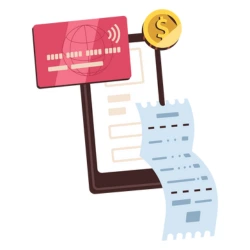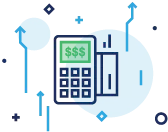A transaction ID is a unique identifier code assigned to each sale that takes place between a customer and a merchant. This identification number is vital for tracking each transaction, preventing fraud, and simplifying accounting processes. Additionally, when merchants accept payments, this unique identifier is sent to the payment processor for verification purposes. Transaction IDs are also beneficial for customers, serving as reference numbers for their purchases to ensure the accuracy and security of their transactions. Typically, customers receive payment IDs either through a confirmation email or printed on their physical receipt.
Now that we’ve established the significance of transaction numbers for merchants and consumers alike, read on as we explain more about how they’re used and why they matter so much.
What Is a Transaction ID?

A transaction ID (T-ID) is an alphanumeric string of characters that serves as a unique identifier associated with any financial transaction. This includes any transaction from a credit card payment to a cryptocurrency wallet transfer.
Essentially, a transaction ID is a reference number that keeps all records associated with a transaction in one simple-to-find place. It helps anyone involved in the transaction quickly and easily access associated records and information about it. For example, you can use this code to see details on any pending transactions like the delivery information, payment type, and transaction date.
Depending on your payment processing partner, the transaction ID format will vary. For example, a payment service provider ID number will look very different from a payment processor transaction ID.
How Are Transaction Numbers Used?
For any transaction, be it sending or receiving funds, the parties involved will receive a one-of-a-kind identification number. This identifier serves as an ever-present record for both parties to know how much money was sent and received. If there is any discrepancy between what a customer was charged and what was agreed upon at the time of purchase, a transaction ID will help the parties gain clarity on who initiated and authorized the transaction.
Transaction IDs are extremely useful in the event of a chargeback or refund, as these disputes can be resolved without the need for an intermediary. Additionally, customer service agents can use this number to look up a particular transaction in the event of an issue. This helps ensure merchants, their products, and their customers are all protected.
Why Are Transaction IDs Important?
A transaction ID is an invaluable piece of information for both the business and the customer involved in a transaction. For businesses, it provides a method of tracking payments through which they can monitor inventory, track revenue, and keep an accurate accounting record. On the customer side, a transaction ID also serves as a record, without which customers run the risk of not being able to return an item, prove their purchase history, or resolve disputes.
Transaction ID Example: What Do They Look Like?
As discussed, a transaction ID is an alphanumeric code that generates for each initiated financial transaction. A T-ID typically contains a combination of uppercase and lowercase letters and numbers. It can be up to 64 characters, but its actual composition will vary by the payment processor.[1]Google Answers. “Use a transaction ID to minimize duplicate conversions – Google Ads Help”. Accessed April 28, 2023.
You can often identify this code by its starting character, as either the letter “T” or “P” stands before a string of numbers. For example, a transaction ID number may look like this: T1234-5678-9012-3456. A PayPal T-ID, on the other hand, may look more like this: 93DJ2231ADD35672D.
Where Can I Find a Transaction ID Number?
T-IDs are easy to find. They are often located on an invoice or receipt near other relevant information, like the business’s name, order number, and purchase date. Below, we look at how to find transaction IDs on different platforms.
On a Purchase
For customers, the receipt, email confirmation, or website confirmation should display a transaction ID after any sale, return, or exchange. In the event of a purchase, it’s typically one of the first listed numbers. Your customer can identify it by looking for “Transaction ID” or “TID” on their proof of purchase. If you’re a merchant, your copy of the receipt, email references, or payment gateway should have this information. If you’re unsure of how to locate a transaction ID, your merchant services provider can help you identify it.
PayPal
A PayPal transaction ID, like all payment IDs, is a unique sequence identifying a purchase or transaction. If you’ve made a purchase through PayPal, check your email receipt for your T-ID.
If you’re a merchant, here’s what you need to know: A PayPal transaction ID is unique from other T-IDs in that it is always 17 characters long. You can find this number in your PayPal account under the Payment Quick Status report by following the below steps:
- Click Campaigns.
- Click the List View tab.
- Select “Events” from the Campaigns menu.
- Select “Active” from the Status menu.
- Select an option from the “Sort By” menu.
- Next to your active event, click “Reporting.”
- On the right-hand side, click “Payment.” This will bring up your transaction history. Each record on this report run through PayPal should have a transaction ID listed.
Cryptocurrency
According to Bitcoin, you must follow the steps below to access your cryptocurrency transaction ID:
- Access your crypto wallet through Bitcoin.
- Select your BCH, BTC, or ETH wallet, depending on the transaction you’re looking for.
- Once here, you should be able to view all relevant transactions.
- Click on the transaction you are looking for.
- Next, click “View on Block Explorer” or “Share Transaction.”
- Once you are on this page, you can access your cryptocurrency transaction ID.[2]Bitcoin Support. “How to find a transaction ID (txid) | Bitcoin.com Support Center”. Accessed on April 28, 2023.
There are numerous types of cryptocurrencies and exchange platforms, but generally speaking, accessing your list of transactions should help you find any T-ID in question.
Google Wallet
A Google Wallet transaction ID is a unique code associated with transactions made through Google Wallet. This transaction number allows you to keep track of your purchases online, as well as provide proof of payment if there are any discrepancies. The most common place to find your T-ID is within an email confirmation receipt sent after completing a purchase. It also may appear on the confirmation page once you have successfully completed an order. If you’re a merchant, your transaction records should offer the same information.
Can Transaction IDs Be Tracked and Traced Back?
While transaction IDs link to sensitive information like customers’ names and addresses, it’s extremely hard for fraudsters to track or trace transaction numbers. It is possible, but very improbable. The only way for someone to track a T-ID is if they have the exact identification number or access to the system that processed the transaction. This makes payment IDs pretty much untraceable for fraudsters.
Can Someone Commit Fraud with a Transaction ID?
No. Because transaction IDs are usually sent to customers via forms of communication to which only they have access, it’s very difficult for fraudsters to use a T-ID to perpetrate their schemes.
In fact, transaction numbers offer protection against fraudulent activity. They are crucial to most fraud protection plans. Using these identifiers, payment processors can retrieve the transaction details in question with ease. Without this number, you’d be missing a lot of key transaction details.
How Transaction IDs Help With Chargeback Management
Transaction IDs are a powerful tool for preventing chargebacks and, if they should occur, successfully disputing them. Because these codes provide businesses with a unique identifier linked to an individual transaction, merchants can easily access customer information necessary for fighting a chargeback dispute. As such, having access to this information gives businesses added protection against unnecessary or fraudulent chargebacks.
Additionally, when customers request refunds, transaction IDs can quickly verify whether the customer has ever completed a purchase with the business. This ensures businesses only handle valid requests for refunds or exchanges.
Merchant Transaction ID Numbers: Final Thoughts
Transaction ID numbers are a crucial element of any financial transaction. They allow both merchants and customers to easily track purchases, transfers, invoices, and other payment types. And with so many transactions occurring online nowadays, T-IDs are especially important in that they help both merchants and customers feel secure when sending or receiving digital payments. However, transaction IDs don’t simply make the associated parties feel secure in regard to the transaction; they also add a layer of real security to transactions that can help prevent chargebacks, fraud, and other payment-related issues. It’s worthwhile to speak with a merchant services provider about chargeback protection management to further secure your business.
Transaction Numbers: FAQs
What is a payment ID, and is it different than a transaction ID?
A payment ID and transaction ID may seem like the same thing, but they are actually different. A payment ID is a unique identifier that is always associated with a payment. While this does sound like a transaction ID, a T-ID follows transactions even if a purchase does not take place.
An example of this would be if a cardholder used points instead of cash to make a purchase or if a transaction declined. There is no monetary payment, but a transaction ID still generates.
Are transaction IDs different between processors?
Yes, transaction IDs are different, as their formatting depends on the processor used for the transaction. This is one of the reasons transaction IDs are so hard to trace. In order to trace a T-ID, one would need to know the exact transaction number and the processor that facilitated the transaction.
How can I find transaction details with a transaction ID?
If you’re a customer who initiated a transaction, all you need to do is locate the receipt, email confirmation, or order history with the business from which you made the purchase.
If you’re a merchant, you’ll need to log into your payment system and enter the transaction details through a search. Your merchant services provider can help you with this process if you’re unsure of how to do it.
Where is the transaction number on a receipt?
A transaction number on a receipt is typically found near other important transaction details like billing address, merchant name, date of transaction, etc.
Where is the transaction number on a check?
The transaction number on a check is simply the check number. It’s typically in the upper right-hand corner of the check. On a personal check, it will usually be a three- or four-digit number.







